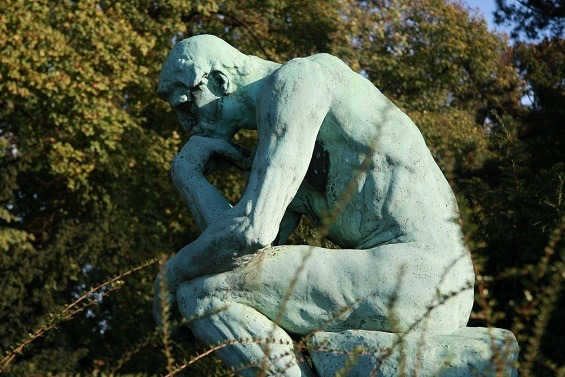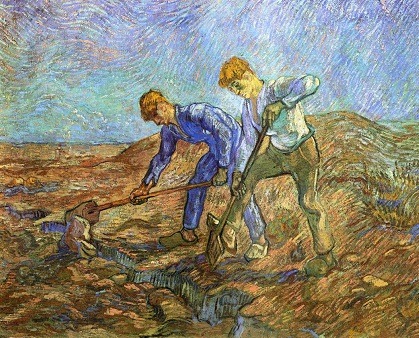Today's Bruxellois are more than used to the city's characteristic mix of languages, backgrounds and cultures. But this hasn't always been the case. In 1960, the number of non-Belgians in Brussels stood at just 7%. By 2006, this number was 56%. So who were these first arrivals that set the precedent for Belgium's capital being the place to welcome everyone, no matter their background or origins? Looking back through the history books, you might be surprised to realise that Brussels' reputation as the safe-harbour of Europe developed much longer ago than we realise – before the formation of the EU, even before the existence of the Kingdom of Belgium.
1) Karl Marx
Hounded by the Prussian authorities and expelled from France, revolutionary and communist icon Karl Marx renounced his Prussian nationality and moved to Belgium. At the time, the newly-founded country had one of the most liberal constitutions in Europe. It was in the bar of a 17th century Baroque mansion on Grand Place where Marx wrote his Communist Manifesto. Marx used the back room to educate workers about their exploitation. It was in this same building where the Belgian Labour Party was formed in 1885. You can still visit the spot where modern socialism was born – oddly, now a gourmet restaurant, Le Cygne.
2) Lord Byron
In 1816, Lord Byron fled Britain never to return. Facing accusations of incest and insanity (as well as mounting debts), England's great Romantic poet sought refuge in Brussels - rumour has it, stealing a carriage and bedding his chambermaid as soon as he arrived. During his stay in a house at No. 51 Rue Ducale, Brussels, Byron penned a famous poem, “Childe Harold’s Pilgrimage: Canto 3”, inspired by his visit to the battlefields of Waterloo. One year earlier, the townhouse had played host to the English poet Walter Scott, who also wrote a poem there about the war, entitled “The Field of Waterloo”. A plaque next to the door commemorates No. 51's literary legacy.
3) Auguste Rodin

One of the examples of Auguste Rodin Rodin’s iconic “Thinker” is at Brussels’ Laeken cemetery.
In 1871, a young sculptor struggling to scrape a living in France moved with his master to Brussels. The master was Albert-Ernest Carrier-Belleuse who designed much of Paris' Garnier opera house and the Louvre. The apprentice was Auguste Rodin. During the six years that he lived in Brussels, Rodin worked on sculptures and ornamentation for the city's Bourse, the Boulevard Anspach and the Palais Royal. He also began work on his famous statue, The Age of Bronze, a life-sized male nude so perfectly sculpted that Rodin was accused of having cast the work from a living model. One of the examples of Rodin's iconic Thinker can still be seen bowing its bronze head over memorials at Brussels' Laeken Cemetery.
4) The Brontës
When we think of the Brontës, the first image that springs to mind is that of the wild and windswept Yorkshire moors. Yet Charlotte and Emily Brontë spent a number of their formative years in Brussels at the Pensionnat Heger on Rue d'Isabelle. The boarding school where the sisters both studied and taught is also where Charlotte met Constantin Heger, the dark haired, cigar-smoking tutor she quickly became infatuated with. Heger later became the prototype for many of Charlotte's male love interests, including Monsieur Paul Emanuel in Villette and Mr Rochester himself. The site where the Pensionnat Heger once stood is now Brussels' Palais des Beaux Arts. The Brussels Brontë Group organises talks and guided tours about the sisters' time in Brussels.
5) Victor Hugo
When the author of Les Misérables caught his first glimpse of Brussels' Grand Place, the only words he could think of to describe the square were: “a miracle". After the fall of Napoleon at Waterloo, French revolutionaries began flocking to Belgium, Victor Hugo among them. He took up residence in the building, Le Pigeon, on Grand Place. Brussels provided the setting for two of Hugo's career breakthroughs: the first was the publication of Les Misérables in 1862, the second was the first theatre performance of his great novel a year later. Every day Hugo would wander down the passages of the Galeries Royales Saint-Hubert to visit his beloved mistress, Juliette Drouet. Drouet's former home now houses Brussels' famous Tropismes bookshop (and, of course, plentiful copies of Les Mis).
6) Kings Charles II and James II of England
His father executed and his army defeated in battle by Oliver Cromwell, King Charles II escaped England on a boat, disguised as a servant. Expelled from the Netherlands and from France, Charles arrived in Brussels with his younger brother, the future James II, in 1658 and they began rallying an army to recapture their kingdom. Two years later, Charles was invited back onto the English throne. But when Parliament began questioning James' right to succeed his brother, Charles was forced to send him into exile. Once again, Brussels sheltered England's banished royalty.
7) Vincent Van Gogh

Vincent Van Gogh enrolled in Brussels art academy after having failed in his previous attempts in becoming a preacher and teacher. He lived in modest conditions at No. 72 Boulevard du midi.
Before he took up his paintbrush and easel, Vincent Van Gogh was determined to become a preacher. Having failed his theology entrance examination in Amsterdam, Van Gogh began a course at a Protestant missionary school in Brussels. Again he failed. After an unsuccessful stint as a missionary in a mining village in Belgium, Van Gogh decided to walk the 75 kilometres back to Brussels and two years later was enrolled at the city's art academy. He took a room at No. 72 Boulevard du Midi, though he complained constantly about not being allowed to hang up his drawings on the walls.
8) Erasmus of Rotterdam
Behind the door of a picturesque Gothic canon's house in sleepy 16th century Anderlecht, modern humanism was taking shape. In 1521, Erasmus of Rotterdam, one of the leading scholars of the Renaissance, moved to Brussels to work on his translation of the New Testament. The house where Erasmus lived and studied is now one of the oldest museums in Brussels. Its two splendid gardens pay tribute to his two legacies: medicine and philosophy. One is full of 16th-century plants once used by Erasmus for medicinal purposes, the other hosts art installations designed to inspire reflection and discussion. The thousands of students studying in Belgium and across Europe on the Erasmus programme today are a living reminder of the writer's contribution to learning.
9) José de San Martín
Statesman, soldier and national hero, Argentinean-born José de San Martín is considered one of the great Liberators of South America. The General helped win independence for Peru, Chile and Argentina. After a mysterious meeting with fellow revolutionary Simón Bolívar, San Martín decided to set sail for Europe, exiling himself to Brussels. In 1975, a statue of the General on horseback was erected by the Argentinean government at the intersection of Avenue de Tervueren and Boulevard de la Woluwe.
10) Paul Verlaine and Arthur Rimbaud
After a violent row in London, which resulted in Verlaine slapping Rimbaud in the face with a fish, literature's two greatest poètes maudits ran away to Brussels. Their attempts to make a new start to their tumultuous homosexual love affair proved in vain. The plaque outside No. 1 Rue des Brasseurs commemorates the spot where Verlaine, in an absinthe-fuelled rage, locked Rimbaud in their hotel room and shot him in the wrist when the latter threatened to end their relationship. It was during the two subsequent years that Verlaine spent in prison in Brussels that the poet composed most of his masterpieces.

